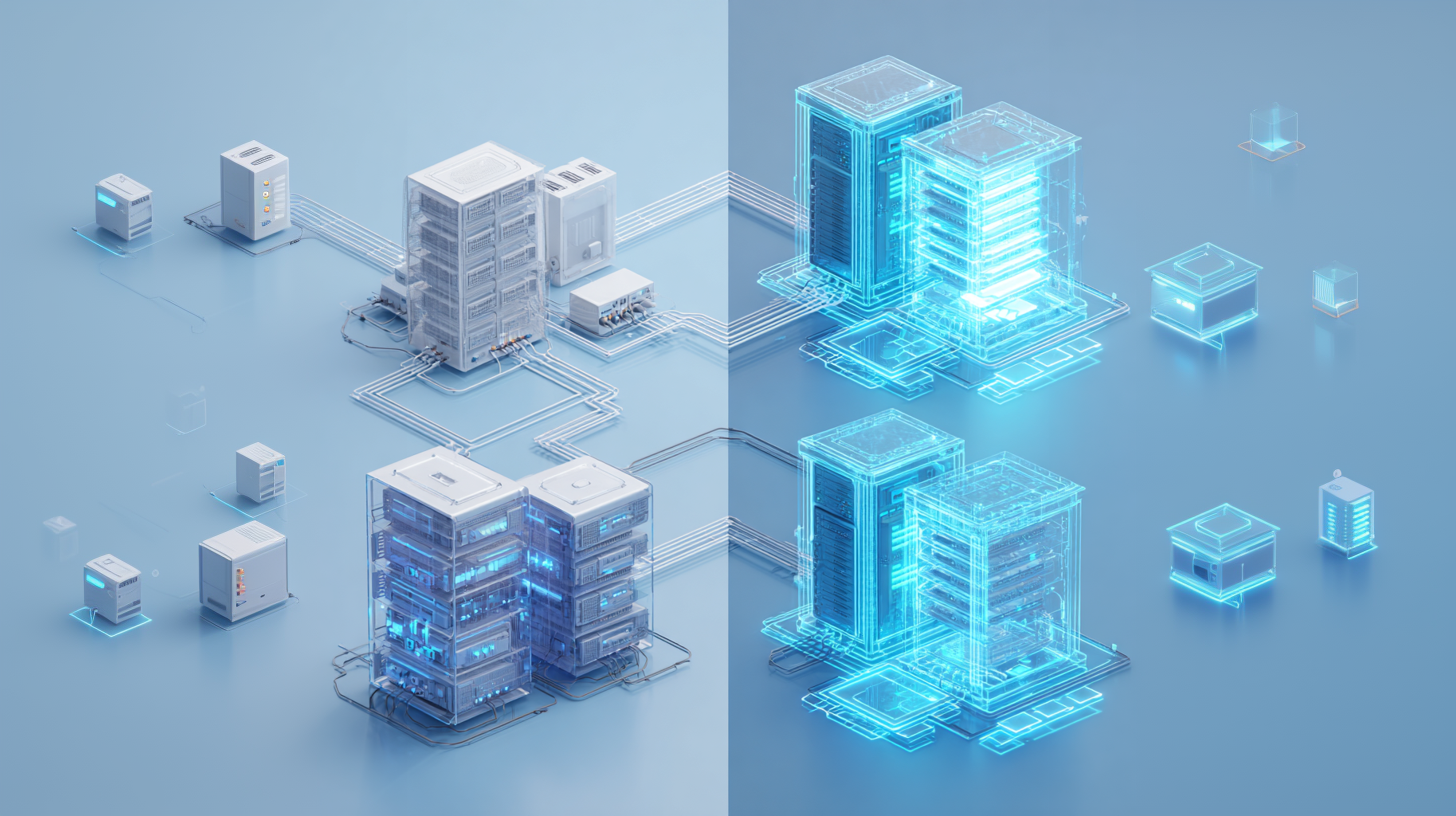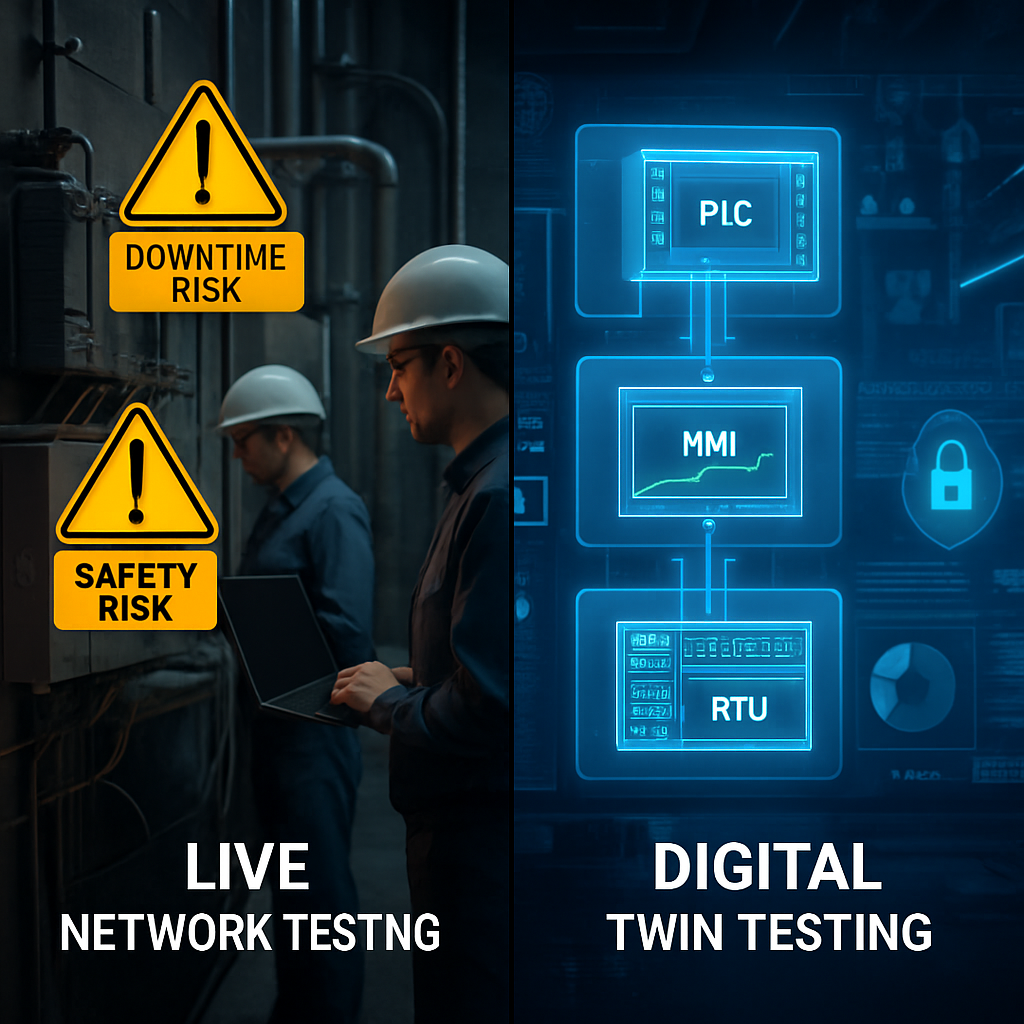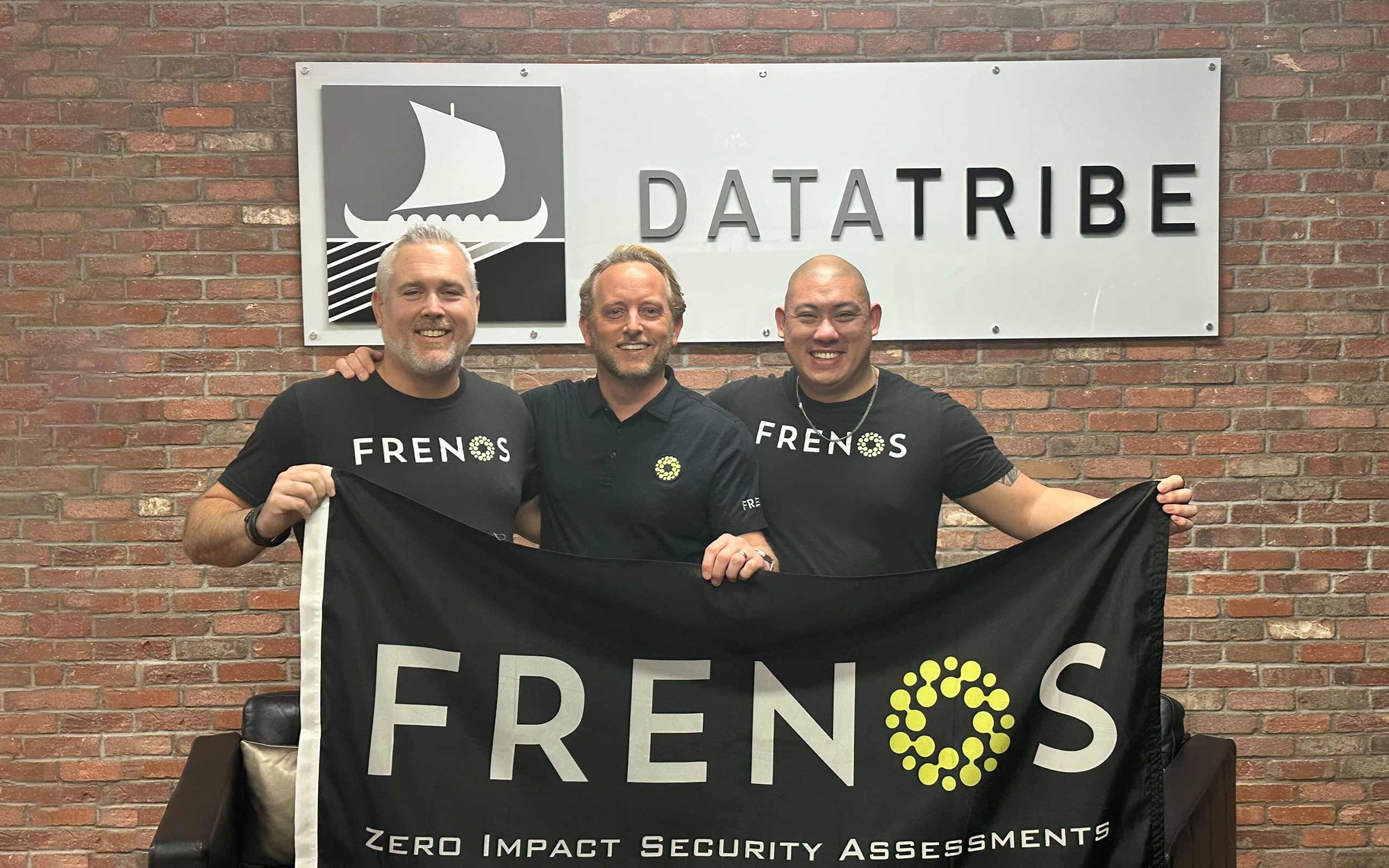The operational technology (OT) security landscape has reached a critical inflection point. Nearly three-fourths of OT professionals experienced intrusions that impacted OT systems in some way in 2024, up from only 49% in 2023. Yet despite this alarming trend, many organizations continue to rely on traditional penetration testing approaches that carry significant risks and limitations when applied to industrial control systems.
Traditional penetration testing approaches often focus on the wrong outcomes and can cause unintended disruptions with severe consequences including production outages, injury to personnel, loss of life, and environmental hazards. The fundamental challenge lies in the unique nature of OT environments, where availability is paramount, and even a simple network scan could already be sufficient to disrupt the working of a PLC.
The Hidden Costs of Traditional OT Penetration Testing
Traditional OT penetration testing faces a fundamental paradox: the very techniques needed to identify vulnerabilities can cause the operational disruptions they're meant to prevent. Testing in a live OT environment, such as a power plant or manufacturing facility, can have serious consequences, including operational disruptions, safety incidents, and even physical damage. This reality forces organizations into an uncomfortable position where comprehensive security assessment becomes a significant operational risk.
The financial implications extend far beyond the initial testing costs. The average cost of a penetration test is between $10,000 and $35,000, but this figure represents only the surface-level expense. When factoring in the coordination required for maintenance windows, the potential for production disruptions, and the limited scope that safety concerns impose, the true cost of traditional OT penetration testing often exceeds $100,000 per comprehensive assessment.
Penetration testing is a simulation of a real attack, which may happen in the future, penetration testing will have the same effect as a real attack if it is not manageable and affects the plant operation. This inherent risk has led many organizations to either avoid thorough testing altogether or limit assessments to superficial scans that fail to identify critical vulnerabilities.
The time factor presents another significant challenge. Traditional OT security assessments often require months of planning, coordination, and execution. Appropriate precautions are always taken accompanied by a testing strategy that is thoroughly detailed and agreed upon, but this thorough preparation process can extend assessment timelines to 12-16 weeks for comprehensive evaluations of complex industrial facilities.
The Digital Twin Revolution in OT Security
Digital twin technology represents a paradigm shift in how organizations approach OT security testing. A digital twin allows you to do a lot of security testing before even touching the real system. This security testing can include automatic, periodical testing or penetration and system testing. By creating an accurate virtual representation of the OT environment, organizations can conduct comprehensive security assessments without any risk to production systems.
The technical foundation of Frenos' digital twin approach differs fundamentally from traditional replication methods. Rather than creating a physical simulation of industrial processes, Frenos constructs a graph-based digital replica that maps communication flows and reveals the art of the possible within OT networks. This graph database architecture treats every asset, vulnerability, and communication path as interconnected nodes, enabling a fundamentally different approach to security analysis.
The power of this graph-based approach lies in a critical insight: defenders think in lists, attackers think in graphs. Traditional security approaches organize information in hierarchical lists with IP addresses, vulnerabilities, assets but attackers see networks as interconnected webs of opportunity. By overlaying asset and vulnerability data as nodes on a communication flow graph, Frenos enables security teams to think like attackers, identifying complex attack paths that linear analysis methods cannot reveal.
Digital twin (DT) technology offers a virtual environment for secure vulnerability assessments and penetration testing, mitigating risks without operational disruptions. The graph-based approach allows security professionals to simulate complex attack scenarios by understanding how vulnerabilities can be chained together across communication paths. This comprehensive testing capability provides organizations with insights into their security posture that traditional list-based approaches simply cannot deliver.
The continuous nature of digital twin assessments provides another significant advantage. The Frenos Platform can continuously assess the security posture of environments at scales unachievable by red teams, consultants, or third parties without putting a single packet on your network. By continuously updating the graph with new vulnerability data and communication flow changes, organizations maintain current visibility into evolving attack surfaces as systems evolve and new threats emerge.
Real-World Impact: From Months to Hours
The transformation in assessment timelines represents one of the most dramatic benefits of digital twin technology. Consider the case of a major power utility that traditionally required three months to complete comprehensive OT security assessments. The process involved extensive planning phases, coordination with multiple operational teams, careful scheduling around maintenance windows, and cautious execution to avoid any disruption to power generation or distribution systems.
By implementing a digital twin approach, this same utility reduced their assessment timeline from three months to 48 hours. The first AI-Native platform combining a digital twin and AI reasoning agent (SAIRA) to proactively defend critical operations enabled the utility to conduct continuous security assessments without any operational impact. The graph-based digital replica captured every communication flow within their control systems, from programmable logic controllers to SCADA networks, creating nodes for each asset and vulnerability while mapping the interconnected pathways between them.
This transformation didn't just improve speed; it fundamentally changed the depth and quality of security assessments. We can take you much farther, all the way to impact and process impairment. That is not something you can do on live production OT environments. The utility could now explore attack scenarios by following graph-based attack paths that would be impossible to identify through traditional list-based analysis, including complex multi-hop attacks and sophisticated supply chain infiltration routes.
The continuous assessment capability provided by digital twin technology means that security teams no longer need to wait for scheduled maintenance windows or coordinate complex testing scenarios. By combining the digital twin and AI, Frenos enables organizations to perform continuous security assessments, identify vulnerabilities, and prioritize risk mitigation efforts. This ongoing visibility ensures that new vulnerabilities are identified and addressed quickly, rather than waiting for the next scheduled assessment cycle.
The Economics of Virtual Testing
The financial advantages of digital twin-based security assessments extend far beyond simple cost reduction. Traditional OT penetration testing, with its requirement for extensive planning, coordination, and careful execution, often costs organizations between $100,000 and $300,000 for comprehensive assessments when all factors are considered. These costs include not only the testing services themselves but also the operational coordination, potential downtime, and the limited scope imposed by safety concerns.
Digital twin technology fundamentally changes this economic equation. All testing occurs in the isolated digital twin, ensuring your operations never face disruption. This elimination of operational risk removes many of the hidden costs associated with traditional testing approaches. Organizations no longer need to coordinate maintenance windows, staff additional personnel during testing periods, or accept the limited scope that safety concerns impose.
The continuous nature of digital twin assessments provides even greater economic value. Rather than periodic point-in-time assessments, organizations can maintain ongoing visibility into their security posture. Instead of outcomes varying widely depending on individual assessors, you obtain a reliable, real-time snapshot of your OT network's security posture. This consistency and reliability eliminate the variability that often plague traditional testing approaches.
The platform reduces the time required for OT security assessments from months to minutes, enabling organizations to conduct more frequent and comprehensive evaluations. This increased frequency means that security teams can identify and address vulnerabilities much more quickly, reducing the overall risk exposure and potentially preventing costly security incidents.
Advanced AI-Driven Attack Simulation
The integration of artificial intelligence with graph-based digital twin technology represents the next evolution in OT security testing. SAIRA, our Simulated Adversarial Intelligence Reasoning Agent, has received significant upgrades, featuring expanded attack path analysis and advanced adversarial AI capabilities within the Frenos digital twin. This AI-driven approach enables security teams to explore attack scenarios with a level of sophistication and depth that manual testing cannot match, particularly by thinking in graphs rather than lists.
The first AI reasoning agent that thinks and acts like a threat within the Frenos platform provides organizations with insights into how actual attackers would navigate their graph-based network topology. The AI agent can traverse complex attack paths through the graph database, identifying how vulnerabilities on different nodes can be chained together across communication flows, and simulate sophisticated adversarial behaviors that linear analysis methods would miss.
AI/ML models can interact with these graph-based digital twins to simulate different attack scenarios, assess the effectiveness of security measures, and identify potential vulnerabilities by understanding the art of the possible within network architectures. This capability allows organizations to understand not just what vulnerabilities exist, but how they connect through communication paths to create exploitable attack chains. The AI agent can simulate everything from basic network reconnaissance to advanced persistent threat techniques by following graph-based pathways that mirror attacker thinking.
The continuous learning capability of AI-driven testing ensures that assessments remain current with evolving threat landscapes. As new threat intelligence emerges, AI reasoning agents adapt their models to recognize novel attack patterns. This adaptive capability means that organizations benefit from the latest threat intelligence without requiring manual updates to their testing procedures.
Implementation Without Disruption
One of the most compelling advantages of digital twin technology is the ease of implementation. Unlike digital twins of the past, we can implement the Frenos platform in a matter of minutes and results within hours of installation. This rapid deployment capability means that organizations can begin benefiting from comprehensive security assessments almost immediately, without the lengthy planning and coordination phases required by traditional approaches.
Creates an exact virtual copy of your OT environment using existing data; no scanning, hardware, or agents required. This approach eliminates many of the technical and operational barriers that often prevent organizations from conducting thorough security assessments. The graph-based digital replica can be constructed using existing network documentation, configuration files, and system inventories, automatically creating nodes for assets and vulnerabilities while mapping communication flows between them.
The platform's ability to operate on commodity hardware makes it accessible to organizations of all sizes. It works on commodity hardware such as modern laptops, can be installed on-premise or in your cloud, and can be easily operated by junior security personnel. This flexibility ensures that organizations can implement the solution in a way that best fits their operational requirements and security policies.
All that is required is data from your existing cybersecurity solution providers, ensuring zero impact to your operations. By leveraging existing security tool data, organizations can create comprehensive graph-based digital replicas without requiring any additional network access or system modifications. The platform ingests asset inventories, vulnerability scans, and network topology data to automatically construct the graph database that reveals the art of the possible within OT networks.
The Future of OT Security Assessment
The evolution toward digital twin-based security testing represents more than just a technological advancement; it represents a fundamental shift in how organizations approach OT security. The integration of IT and OT makes safeguarding your OT environment more important, complex and difficult than ever. Digital twin technology provides organizations with the tools they need to address these challenges effectively.
Digital twin technology offers a powerful approach to cybersecurity threat modeling and incident response. By creating a virtual replica of an organization's IT or operational technology (OT) infrastructure, security teams can simulate potential cyber threats in a controlled environment. This capability enables organizations to develop more effective security strategies, test incident response procedures, and validate the effectiveness of security controls without any risk to production systems.
The growing adoption of digital twin technology reflects the broader transformation occurring in OT security. 70% of C-suite technology executives at large enterprises are already exploring and investing in digital twins. This executive-level commitment indicates that digital twin technology is moving from experimental to mainstream, with organizations recognizing its potential to transform their security posture.
As the threat landscape continues to evolve, organizations that embrace digital twin technology for security testing will be better positioned to identify and address vulnerabilities before they can be exploited. The combination of comprehensive testing capabilities, continuous assessment, and zero operational impact makes digital twin-based security testing not just an improvement over traditional approaches, but an essential component of modern OT security strategies.
The choice facing OT security managers is clear: continue with traditional testing approaches that carry significant risks and limitations, or embrace the digital twin advantage that provides comprehensive security assessment without operational impact. For organizations serious about protecting their critical infrastructure, the answer is becoming increasingly obvious.
References
- Fortinet. (2024). 2024 State of Operational Technology and Cybersecurity Report. Retrieved from https://www.fortinet.com/resources/reports/state-of-ot-cybersecurity
- SANS Institute. (2024). ICS613: ICS/OT Penetration Testing & Assessments. Retrieved from https://www.sans.org/cyber-security-courses/ics-ot-penetration-testing-assessments/
- Secura. (2024). Vulnerability Testing / Pentesting in an Industrial Environment. Retrieved from https://www.secura.com/services/operational-technology/industrial-vapt
- World Economic Forum. (2025). How digital twin technology can enhance cybersecurity. Retrieved from https://www.weforum.org/stories/2025/03/how-digital-twin-technology-can-enhance-cyber-security/
- Blaze InfoSec. (2025). How Much Does Penetration Testing Cost In 2025? Retrieved from https://www.blazeinfosec.com/post/how-much-does-penetration-testing-cost/
- El‐Hajj, M., et al. (2024). Systematic literature review: Digital twins' role in enhancing security for Industry 4.0 applications. Security and Privacy, Wiley Online Library. Retrieved from https://onlinelibrary.wiley.com/doi/full/10.1002/spy2.396
- Fraunhofer AISEC. (2024). Digital twins and their potential for OT security. Retrieved from https://www.cybersecurity.blog.aisec.fraunhofer.de/en/digital-twins-and-their-potential-for-ot-security/
- Infosec K2K. (2025). The Biggest OT Security Incidents of 2024: Lessons for Critical Infrastructure. Retrieved from https://www.infoseck2k.com/biggest-ot-security-incidents-2024-lessons-for-critical-infrastructure/
- Nomios Group. (2025). Trends and expectations for OT security in 2025. Retrieved from https://www.nomios.com/news-blog/trends-ot-security-2025/



![OT Penetration Testing Checklist: Complete Guide for Before, During & After [2025]](https://frenos.io/hubfs/brianproctor_a_computer_hacking_adversary_in_a_futuristic_wor_985a9c42-7e7a-4185-9582-cf4bc2568a28_0.png)


.jpg)
